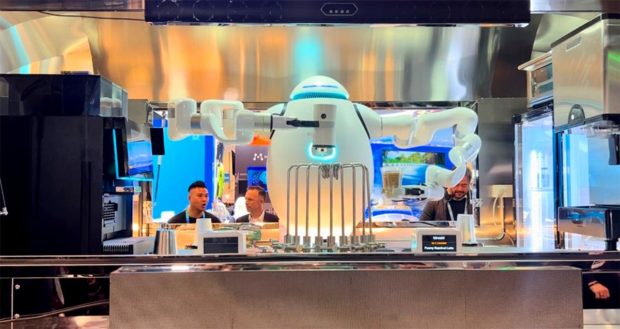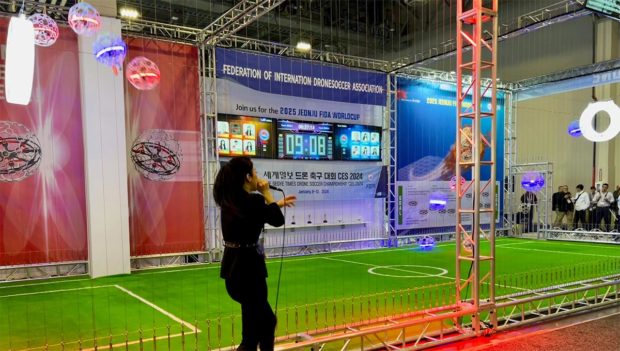It’s hard to get excited about a sensor, but one of the keys to innovation is to see possibilities where others just see a hunk of unapplied technology. And it was the sensors that drew the attention of Don Relyea and his team at the 2024 Consumer Electronics Show.
For Relyea, U.S. Bank’s chief innovation officer, what sensors can do in conjunction with other technologies in the right environment is where customer experience improvement begins. He sees sensors as not only important for the digitization of retail banking locations, but also for shopping and payments where commerce and banking come together physically.
“Those environments are going to become more ‘aware’ of who is in them at the moment,” says Relyea. One example: He and his team saw a prototype shopping space set up by LG Corp. A combination of artificial intelligence, computer vision and sensors presented personalized advertising to booth visitors based on awareness and analysis of the clothing they were wearing.
“We humans have our five senses, but sensors go way beyond those and enable us to see what humans can’t. And now, artificial intelligence is starting to make interpretation of the data coming off the sensors better. So the things they can do are smarter for you.”
— Todder Moning, U.S. Bank innovation team
Embedded sensors have become a big factor in home healthcare, says Moning, head of applied foresights and part of the group visiting the conference. This can run from handheld gadgets like BeamO that can evaluate multiple body functions instantly to “smart toilets” that can perform ongoing monitoring of health. Parallels with banking in financial health and in retail banking environments abound, says Moning.
“There are different types of sensors that can help you detect whether there’s a problem at an ATM or at a branch,” says Relyea. The more that technology enables the adaptation of a location to the individual, the more the line between physical and digital blurs.

Navigating Credit Card Issuing in an Uncertain Economic Environment
Build a modern credit card strategy that balances profitability and risk, adopts the latest technology and delivers the customization that cardholders demand.
Read More about Navigating Credit Card Issuing in an Uncertain Economic Environment

Send the Right Offers to the Right Consumers
Achieve a better return on your marketing investment. Leverage behavioral data and analytics to target the right customers with the best possible offers.
Read More about Send the Right Offers to the Right Consumers
Tech to Support Customers, Tech to Provide Financing Opportunities
“Our strategy is that while we have a super strong digital focus at U.S. Bank, we consider ourselves ‘digital plus human,'” adds Relyea. He and his team not only seek to spot new tools and techniques to improve bank processes, but products that could represent new financing opportunities for U.S. Bank.
Case in point: Genesis Systems’ WaterCube. “It’s a box about the size of an outside air conditioner,” says Moning. The WaterCube can pull over 100 gallons of water out of the air and can be run on solar power.
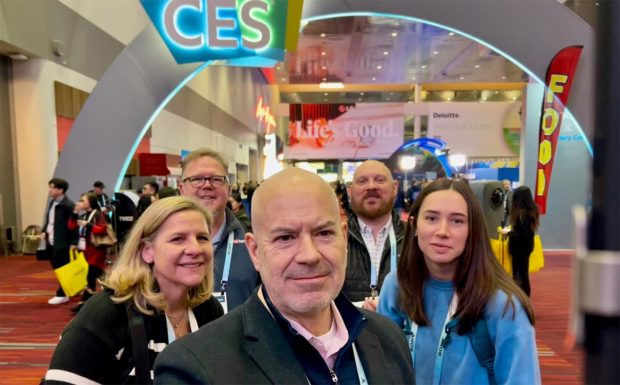
Among the members of the U.S. Bank team visiting CES: foreground, Todder Moning, head of applied foresights; second row, Cynthia A. Jackson, VP/digital innovation, l., and Rosa Dunn, AVP/digital innovation; third row, Don Relyea, chief innovation officer, l., and Andrew Cantrell, Sr., applied foresights strategist.
“What does that have to do with banking?” says Moning. “Lots of folks in our markets have wells, which can cost $40,000-$80,000 to drill. This machine costs $20,000-$30,000. So, while that’s expensive, if it’s going to answer all of your water needs without having to be connected to the water system, that’s interesting.” He sees it potentially tying in with a developing trend of young people, unable to afford homes at current prices and interest rates, opting for remote work from RVs.
Read more: Synchrony’s Innovation ‘Strike Zone’ Spans Embedded Finance, Social Selling and Web 3
Seeing Booming New Tech at CES Through a Banking Lens
U.S. Bank has been sending teams to CES for years in what Relyea and team members call “safaris” to find new tech and new applications that innovators and line of business staff can pilot in different parts of the bank. This year, the group included people from the bank’s innovation and digital teams, as well as from a line of business and communications staff. (Among other things the latter was there to help bring back the sense of the show for many employees not attending.)
Digging for the banking use cases behind the technologies on display is critical, because Relyea says many vendors don’t “get” banking and its needs. An example: He and team members were discussing the possibilities for a sensor and related chip at a company’s booth.
“At one point, the vendor said, ‘My family owns a bank. Why didn’t I think of that?'” Relyea says.
Once the U.S. Bank CES attendees explain what they see in a product, many vendors are surprised by the sheer breadth of needs that larger banks try to meet. “Big banks are in so many different business lines and serve so many different industries and consumer types,” says Moning. “We really have to look at new technologies broadly.”
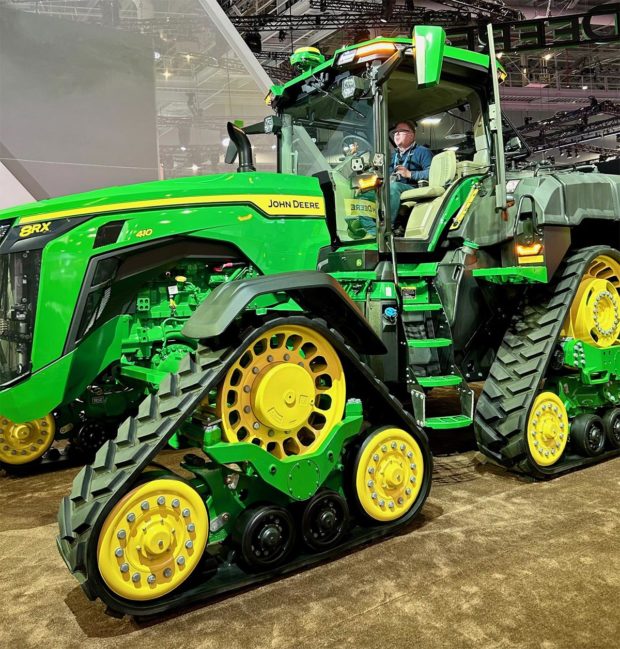
Don Relyea, U.S. Bank’s chief innovation officer, up in the cab trying out a next-generation John Deere tractor that can be operated manually, remotely or autonomously. U.S. Bank is a major agricultural lender and could need to finance such leading-edge farm machinery.
“So, we have to do a little bit of work, digging in with these folks to help them understand our business,” says Relyea.
One standout in direct applicability to banking was South Korea’s Shinhan Bank. Shinhan, in its second time exhibiting at CES, demonstrated banking tech. Something that caught the team’s eye: Facial recognition technology enabling people to access an ATM without a card or smartphone. Shinhan uses the technology in its own offices.
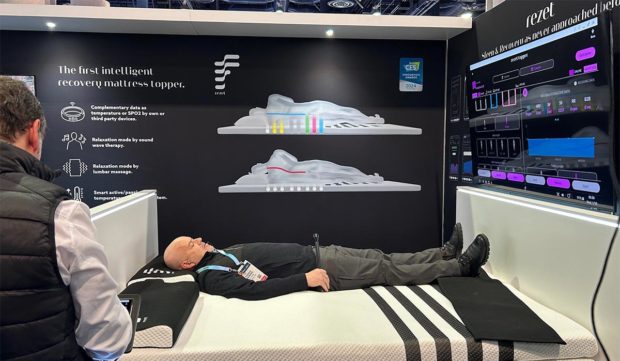
At the other end of the day, there’s sleep and rest. Todder Moning, head of applied foresights at U.S. Bank, gets off his feet to try out Rezet, a bed mattress topper that ties into the internet to help with recovery after a long day at CES — or work.
But at other times, making the connections to banking takes more thought. “We’ve been finding a lot of interesting software-as-a-service companies at the show that might make a good play for our new embedded API financial services platform,” says Relyea. (API stands for application programming interface.)
Relyea says discoveries like these can turn into businesses for U.S. Bank. “We could partner with companies that are doing cloud services for rental agencies, for example, embedding payments into those types of opportunities,” Relyea says.
Overall, “we’ve actually found more things that have the potential to be pilots back at the bank this year than we did last year,” says Relyea. “We didn’t find many that were immediately actionable in 2023, but there are some things we saw this year that are no-brainers.”
Annual visits to CES aren’t solely devoted to spotting customer-friendly technologies; process improvements are also on the bank’s radar. Relyea points to spatial computing vendors like Nimo 1 as an example. The firm’s technology links a pocket gadget called Nimo 1 Core that handles computing with a glasses-like visor that sets up a virtual office in the “air” in front of the user. Gestures control multiple visual interfaces — think of Tom Cruise manipulating screens with gestures in the movie “Minority Report.”
This rolls up remote work and other post-pandemic work trends and also advances computing beyond the concept of mobile devices and desktop machines, says Moning. In time, this trend will mean a lot for the way U.S. Bank employees work.
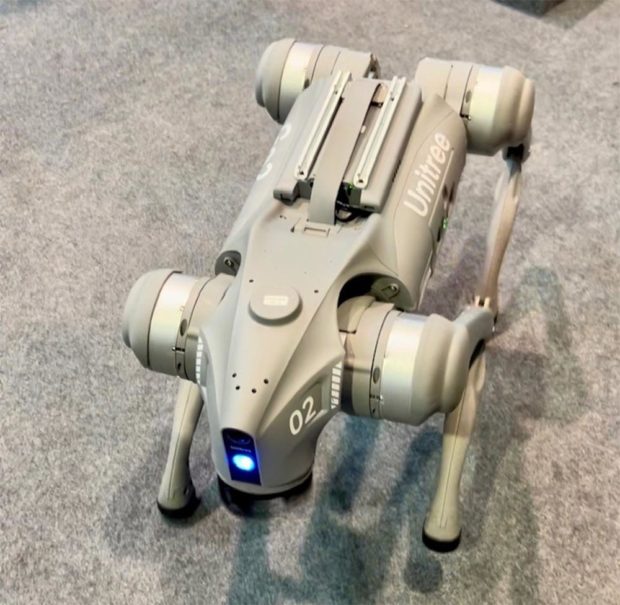
Multiple vendors demonstrated robot “dogs” with many talents. “They can even pick up the trash in your yard, or pick up after your real dog,” says Todder Moning, head of applied foresights at U.S. Bank.
Read more:
- Arvest’s Digital Transformation Focuses on Customer Pain Points
- Why Elon Musk Wants to Disrupt Banking Next
- Why New Market Conditions Require a Refreshed Approach to Banking Innovation

U.S. Bank Is Not Ready for Generative AI Yet
An astute reader might note that we haven’t yet mentioned GenAI.
“We’re taking GenAI with a lot of salt at this point,” says Relyea. “That’s mostly because it’s so cloud-based.” The bank is concerned about security and about protecting customer and internal data.
Even at the conference, Relyea says, he was seeing much more that was based on traditional AI “that’s been refined and working better.”
“It’s been injected into everything from analysis of baseball swings to having your scalp analyzed to understand why my hair isn’t growing where I want it to grow,” says Relyea.
But as for GenAI, “there’s no real clear customer use cases for us at this point,” says Relyea. “But that doesn’t mean that we’re not thinking about it.”

